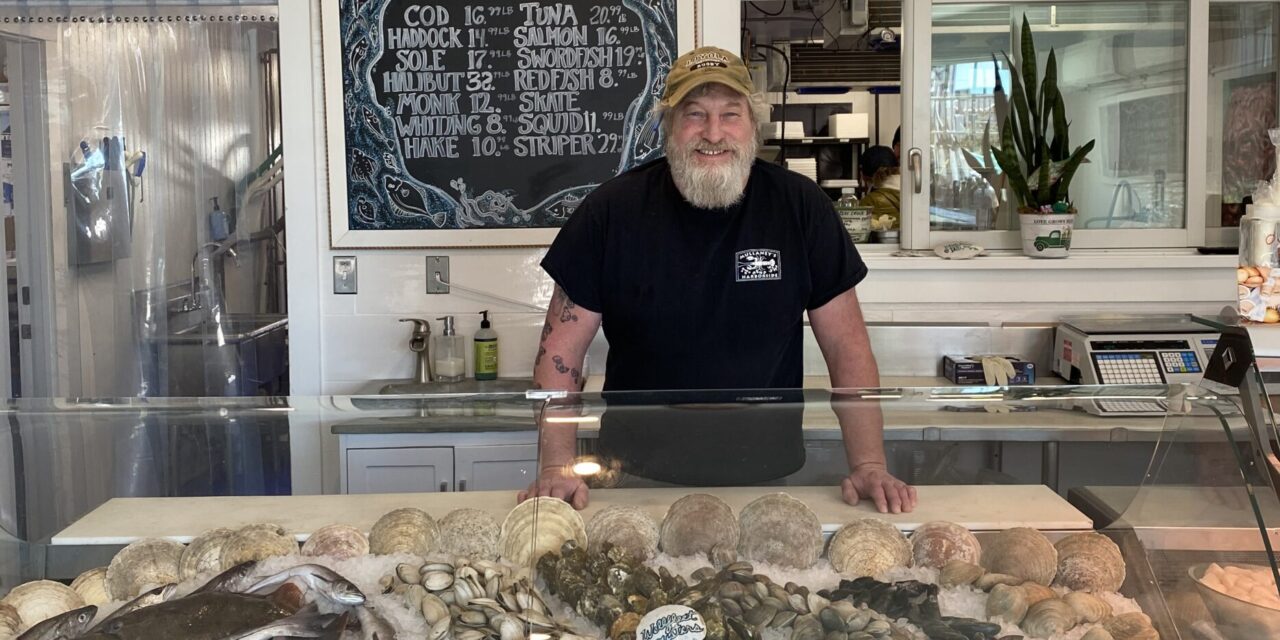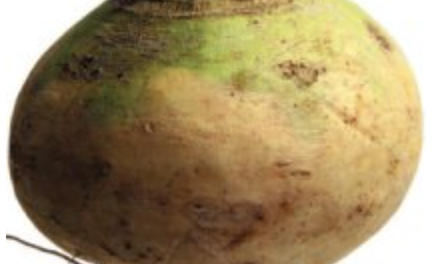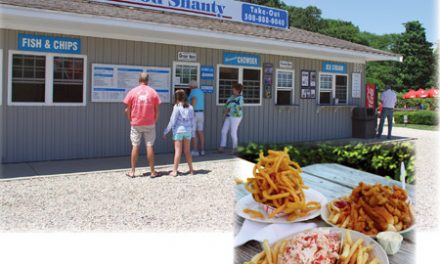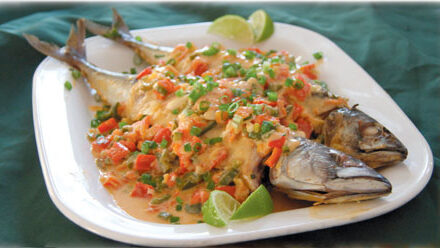Story and Photos By Christine Becker.
A Clarifying Conversation with one of South Shore’s Most Trusted Fishmongers
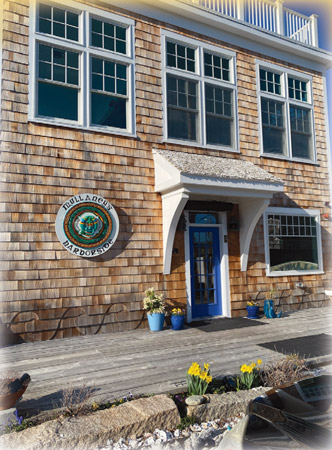
The welcoming blue door at Mullaney’s Fish Market, Scituate.
As I set foot in Mullaney’s Harborside Fish Market, a two-story shingled storefront with a cerulean blue door, my nostrils are immediately filled with whiffs of brine and ice, reminiscent of the cold Atlantic. The plump crab, whole haddock, and pearl-glossed scallops are cradled under an enclosure of dazzling glass and deliver an unexpected, visual feast. Like a child in a candy shop impishly leaning into the counter for a closer look, my eyes were greeted by rows and rows of oceanic fare perfectly poised for culinary adventures and home-grown Sunday suppers—I was almost giddy.
Joby, a towering presence who exudes a particular warmth and humble expertise, entered the market with a hand extended, welcoming me to tour the facility. A Scituate native and a fisherman by trade, Joby is the proud owner and operator of Mullaney’s Harborside Fish Market. “As a customer of Mullaney’s, you never have to ask a quality control question or whether an item is fairly priced. Rest assured that whatever I pick out for the retail market is the same I would feed my own family. I’m a fish guy, first and foremost,” he explains.
Beyond First Impressions
While the rest of the South Shore sleeps in the early morning, Mullaney’s fishers depart the docks at 4 am to scour the North Atlantic for the freshest catch—both for chefs in Boston and for the entire South Shore community. “Commercial fishing in Scituate is the backbone of the whole community, and as one of the only working harbors on the South Shore, we aim to preserve its heritage,” says Joby.
His newly renovated market, boasting a state-of-the-art, energy-efficient processing plant, includes a commercial kitchen suited for Mullaney’s in-house chef’s “Grab and Go” meals. A bonus rooftop patio with harborside views includes contemporary lounge seating, a raw bar, and repurposed lobster tanks filled with kitchen herbs and vegetables. This one-of-a-kind event space provides a private, coastal experience ideal for celebrations and networking socials that customers can book directly at the market.
But there’s more than meets the eye with this market—it’s vertically integrated, for starters. This means Joby oversees every step of the process from the ocean to the plate: catching fish on independently-owned and -operated vessels, processing in-house at the new facility, and finally selling to consumers, both in the Scituate and Cohasset storefronts and in wholesale distribution to restaurants. This Ocean to Plate approach ensures consumers receive the freshest fish possible, often caught within the last 24 to 48 hours.
From an environmental and sustainability perspective, Mullaney’s deserves a gold star for its use of green technology. However, the company is doing something else environmentally remarkable: they purposefully do business with fishers who clean up our oceans. Last year alone, Scituate-based fishing crews picked up and disposed of a whopping 48 tons of trash. When I asked Joby why they do it, he shared: “They pick up a lot of plastic in their nets, and we need to keep that plastic out of our fish and off our South Shore beaches. We have a responsibility to do better. To do the right thing. It doesn’t have to be done for profit all the time. We like seafood. We like to fish. And we like being stewards of the ocean.”

Joby Norton, a towering presence, exudes a particular warmth and humble expertise.
Q: Let’s talk about Ocean to Plate. Given Joby’s expertise as a local fishmonger, I asked him to walk me through how a consumer might choose a fish.
“First, you need to have an educated and passionate staff to engage with customers. The person behind the counter should know where the fish is from, when it was caught, the flavor profile, and how to cook it. At Mullaney’s Harborside, the counter staff won’t say, ‘it came out of a box yesterday.’ There should be zero odor. Sometimes, grocery and fish market counters install lights to showcase their seafood product, and if there are pre-cut fish portions with the skin attached, the light can draw out the moisture from the skin, causing the fish’s surface to look dry or crackly. Remember that pre-cut fish should have a nice, smooth sheen in appearance.
“There’s also nothing quite like a conversation. There’s value in the exchange of information—we want you to feel familiarized and comfortable with our products. I’d encourage consumers by saying: Don’t be afraid to ask a question—build a relationship with your fishmonger,” suggests Joby.
Q: Do you provide recipes to customers if they’re unfamiliar with preparing a particular item, for example, whole cod or monkfish fillets?
“Yes. All recipes are word of mouth at Mullaney’s, handwritten on the back of the fish package upon request. Cod, a quintessential New England fish, is super easy to prepare. The Statehouse served cod, and it’s what your grandparents had on their kitchen tables every Friday night during Lent.”
I imagine cod nestled inside Mullaney’s crisp white butcher paper crackling as it’s wrapped by hand. The sweet, pungent smell of a Sharpie records my now five-step dinner recipe. I can’t help but feel something transcendent about this small-town approach, like sitting down among generations of community members who have enjoyed this exact recipe at their dinner tables. This storytelling approach keeps local traditions alive.

An Ocean-to-Plate approach ensures consumers receive the freshest fish possible, often caught within the last 24 to 48 hours.
Q: What else should a consumer consider when choosing fish? And what differentiates Mullaney’s from other markets?
“We maintain the integrity of our shellfish and fish; we do not adulterate the product by adding salts, water, or chemicals. Sodium Tripolyphosphate is a big one these days. It’s to fish what MSG is to food. Take, for example, a fishmonger who has 10 lbs. of scallops from a boat but adds water and a salt solution; they now have 14 lbs. of scallops which bring in a higher return—but they’re treated and not a pure product. You can increase your profit by $150 by selling water. If you put an additive on cod or a haddock fillet, it won’t spoil for one and half weeks, so you don’t have to sell it as quickly. Our fish is rotated out daily at Mullaney’s, so you’ll always have a fresh piece of fish caught in the last 24 to 48 hours.”
While the U.S. Department of Food and Drug Administration (FDA) recognizes additives such as food grade Sodium Tripolyphosphate are safe for use in food (when adhering to good manufacturing practices), informed consumers can decide whether to purchase treated or untreated seafood.
Q: For consumers, there seems to be some ambiguity around farm-raised salmon. The upside is it’s environmentally sustainable and more cost-efficient, but it can contain additives and antibiotics. As a local fishmonger, can you share a bit about your process in choosing what salmon you’ll carry in the market?
“There’s been a significant increase in the demand for salmon—it’s one of the biggest sellers. Salmon is an excellent protein and economically viable.
“Take, for example, a salmon farm-raised in Chile. There are currently a lot of producers with lower-priced products, which you can often find in supermarkets. These salmon reside in bays where the water is periodically filtered, only at high tide, but stagnant at low tide. But the water needs to turn constantly. The fish are in pens, contained in a polluted area, likely with agricultural runoff and fish poop, which creates an environment where parasites can attack the fish. Here’s where antibiotics come in—a feed with medicine that cures the disease.
“However, in Scotland, Iceland, and Norway, the net pens are dropped deep in the ocean—about one mile out from the coast and 20 feet deep where the water is colder. The strong currents constantly flush through, creating an ideal place for salmon farming. At Mullaney’s, we carry organic Norwegian salmon—this means the farmers’ net pens have a 99% to 1% density (versus a 95% to 5% density for non-organic) and lie fallow after harvest for six months. This critical step allows a natural cleaning process to occur.”
Q: Can we talk about local fish in the region? What can we expect from our New England waters?
“There’s a large assortment of local fish—cod and haddock are classic whitefish. There are five types of sole, monkfish, hake, whiting, redfish, halibut, scallops, mussels, clams, oysters, bluefish, striped bass, and swordfish. Last year, we brought in 600,000 to 700,000 pounds of fish. The Mullaney’s fleet of fisher day boats, outfitted with equipment that can gut the fish 100 times faster, eliminates fish sitting on the ship’s stern. The fish are measured, gutted, rinsed, and put on ice within minutes.”
Q: What’s the health of our fishing stock?
“The fishing stock is very healthy but was on the decline years ago. New regulations and revised fishing practices will help maintain healthy stocks moving forward. There’s also an evolution of a species in real time—meet the haddock. The legal size used to be 21 inches, and now it’s 18 inches, which means it’s moved from 5 lbs. at full maturity (which takes two years) to 2 lbs.”
Q: Anything you’d want the readers to know?
“Kitchen rumors are poke bowls and ceviche are coming this summer, and maybe fish and chips on Fridays, so look out for those. With the facility renovation, I didn’t want to build a restaurant but to sell good food and good fish. The vision has always been high-quality, super fresh “Grab and Go” meals. We also offer 20-course in-house Omakase sushi dinners featuring the freshest catch with sake pairings— customers can find announcements for those events inside the market and on our social media accounts.”
If you ever find yourself strolling along the Scituate harbor, before dusk drapes the summer sky with chromatic hues of saffron and magenta, don’t hesitate to wave and say ‘hello!’ if you notice a fisher docking at the pier. They might have caught what you’ll be having for dinner tomorrow night.
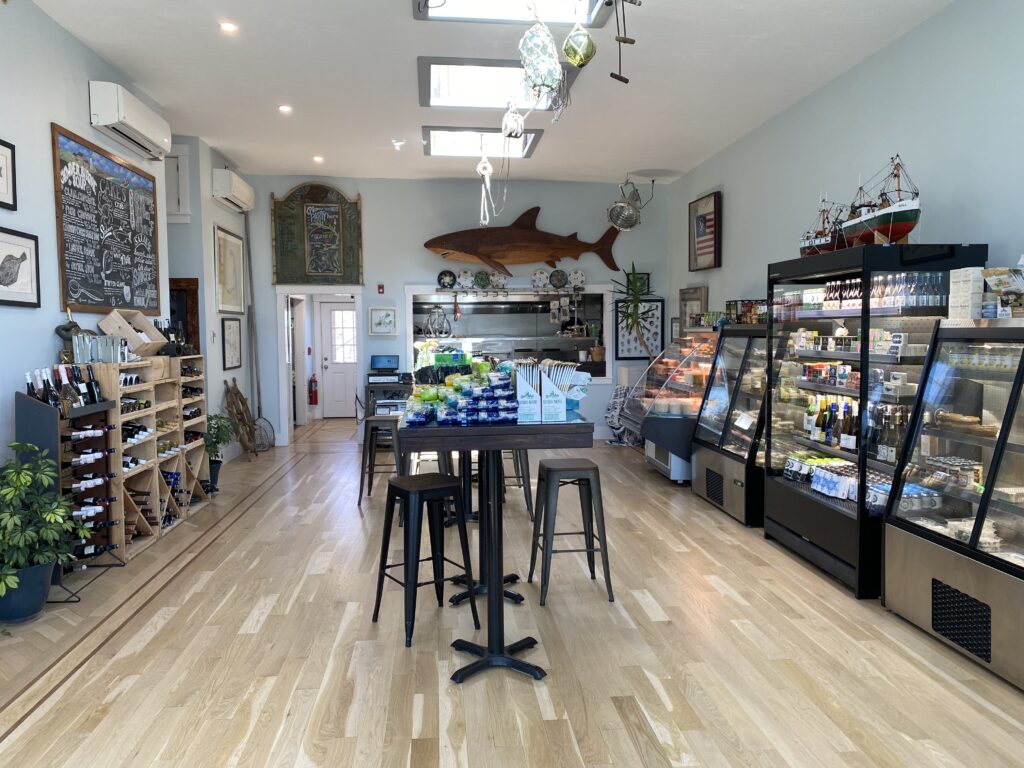
Coolers of freshly prepared spreads and grab-and-go items line the wall of Mullaney’s second floor.
Mullaney’s Harborside Fish Market Retail Stores
8 Allen Place
Scituate, MA 02066
(781) 545-5000
754 Chief Justice Cushing Highway
Cohasset, MA 02025
(781) 383-1181
www.mullaneysseafood.com
Christine Becker is an Atlanta native and new Scituate resident. She’s the Founder and CEO of Food Scribe Consulting, LLC, a boutique firm specializing in evaluative design and fundraising strategy for food system nonprofits. She’s also a local beekeeper, committed vermicomposter, and oyster enthusiast!
This article was originally published in print in the summer 2022 edition and has since been updated online.

